#daphnis et chloe
Explore tagged Tumblr posts
Text
Nerd Hours Nerd Hours
Headcanon: Musicarts can fluently speak the language their score was composed in, so Berlin Symphonica has a creole language of sorts spoken exclusively by Musicarts!

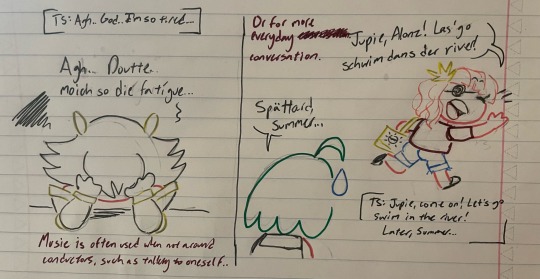
look i even made drawings to support this. as campanella would say, praise me dammit
#takt op#takt op symphony#takt op.destiny#daphnis et chloe#vivaldi#il cimento dell'armonia e dell'inventione#the planets suite
14 notes
·
View notes
Text

Nijinska Scrapbook of Ballets Russes: 1923-1924
#talking#papillons#op. 2#ballet#casino de monte-carlo#palais des beaux-arts#theatre de monte-carlo#ballets russes#daphnis et chloe#le mariage d'aurore#mariage d'aurore#les biches#biches#les tentations de la bergere#tentations de la bergere#petrouchka#prince igor#danses polovtsiennes du prince igor#danses polovtsiennes#sheherazade#une education manquee#education manquee#l. bakst#leon bakst#borodine#alexandre borovskky#h. casadesus#ceresole
0 notes
Text
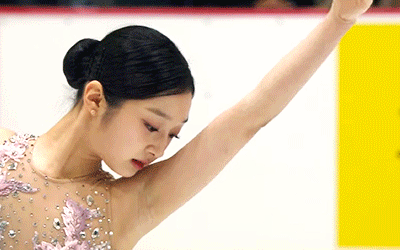
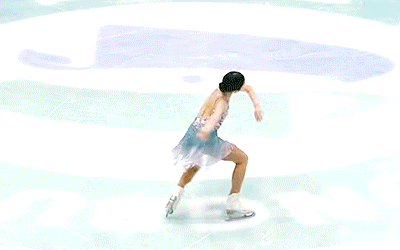



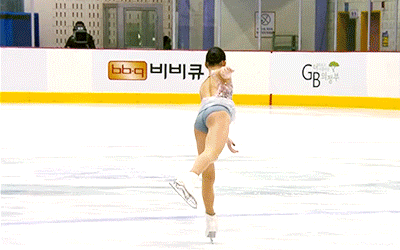


Shin Jia (KOR): Liebesträume No. 3 | 2025 South Korean Nationals, FS
debuting a new program in south korean nationals, shin jia gracefully enters the senior podium for the third consecutive year, placing silver in the competition🥈
#figure skating#jia shin#fskateedit#shin jia#knats 2025#my gifs#i like this program better than daphnis et chloe probably bc this one has a little more flavor?#i know it's pre-olympic season so she wouldnt want to risk and diversify yet esp with puberty#but i wish she'd experiment more#it's beautiful tho#just needs more of a personal touch and soul
77 notes
·
View notes
Text
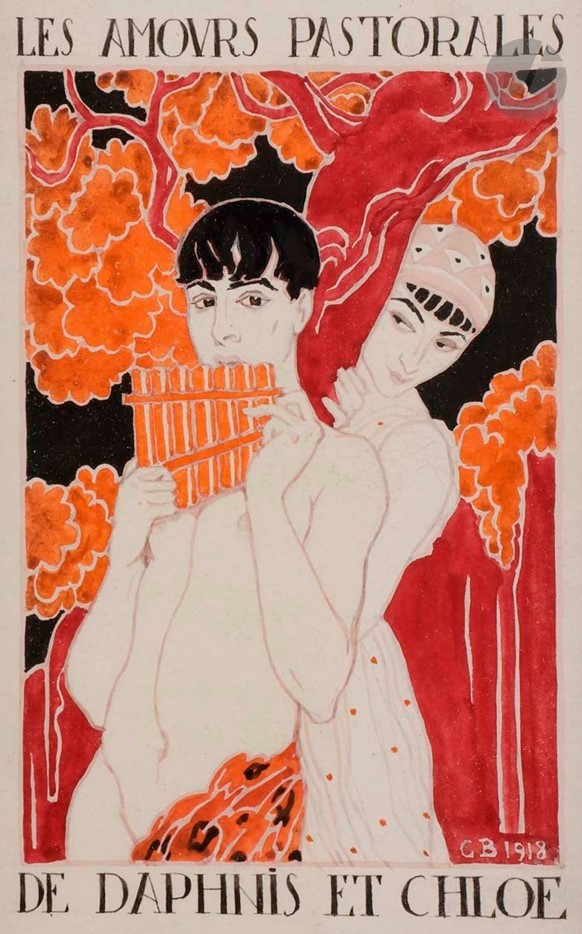
George Barbier, Les Amours pastorales de Daphnis et Chloé, 1918.
The subject of Daphnis and Chloe is distinguished from other Greek novels by its bucolic setting and the constant irony which governs the course of the action.
It is above all their sentimental education which is described throughout the adventures of the novel. The two protagonists live in the countryside, near the city of Mytilene on the islandof Lesbos. Daphnis is a young goatherd, a child found by shepherds (in a laurel grove, hence his name which comes from the ancient Greek δάφνη (daphnè), laurel). Chloé, for her part, is a shepherdess, also a foundling. They grow up in a pastoral setting and fall in love with each other, but multiple twists and turns prevent them from satisfying their love. However, the outcome is a comedy: the two children are recognized by their respective parents, who are rich people from Mytilene, lifelong friends, and who are going to marry them. (x)
#george barbier#1918#daphnis and chloe#Daphnis et Chloé#barbier#longos#roman de gare#illustration#Ancient Greek#Mytilene#lesvos#lesvos island#1918 illustrations#art#art history#lesbians#ancient#greek#homosexual#lgbtq community#lgbtq
46 notes
·
View notes
Text

me drawing my favourite ship as famous paintings ( 2 / ? ) ( this time it's 'springtime' by pierre auguste cot ) extra:

#art#2023#oc: archange#me when im like oh wait i should draw archange art that doesnt have scara in it#and then i dont#its ok its because my scrunkly beloveds#consider this a spiritual sequel to the one that's based on gérard's daphnis et chloe#i was on the fence abt actually posting this bc its so sickeningly self-indulgent im actually embarrassed bwahaha
14 notes
·
View notes
Text
Ohhhhh Boléro my beloved/beloathed. I feel like 85% sure it was namedropped just for the rhyming scheme. But it’s a fun choice for this specific show so i’m gonna act like a clown and ramble 🤡
Because like … okay the whole conceit of the piece is that the underlying rhythmic/harmonic stuff just keeps marching forward in this very relentless and plodding sort of way. Kind of like a ticking clock. Stays pretty much exactly the same throughout. It’s like that poem about how you can’t conquer time.
Then there’s the melody overlaying everything. It’s the same motif over and over and over again. It’s very legato compared to the staccato of the rhythm, which makes it feel even more watery and changeable and kinda hard to grasp even though you WILL have the motif in your head before the piece is done with you lol (now that I’m typing this out it reminds me of sampling hmmm.)
But also the melody basically gets yeeted from soloist to soloist, instrument to instrument. Which means you get different takes on the same musical idea and it keeps it all feeling fresh and interesting despite the potential for boredom. Which is … very relevant for a show about different perspectives on the same events.
But also if you’re playing a viola you never get the melody so you’re playing the same few notes over and over as this fancam illustrates lol
youtube
Which is also a pretty good metaphor for fighting about the same shit over and over again and getting tired of it.
Basically really good choice for this show even though I have a feeling it’s accidental
OK a bit of a different take on the "I'm piano and you're forte. You're allegro, I'm andante. We're boléro, prostitué." It's obviously a big metaphor and here's what I think is going on (I'm not a musician I'm so sorry if these terms are bullshit):
Piano and Forte: Piano is soft, forte is loud. These terms refer to styles of playing but also make up the word for the instrument itself, pianoforte, two sides of the same coin-both needed to be able to play a song.
Allegro and Andante: Andante refers to a tempo of a walking pace 76–108 bpm, Allegro is faster 120–168 bpm "quick" and "bright." I think this is less about how these tempos symbolize Louis and Lestat and more about how they're drastically different and don't seem to match up. Specifically to go into the following line talking about...
Boléro: With the accented e, boléro seems to be specifically referring to the orchestral piece by Maurice Ravel from 1928. I think it's likely this is the reference due to the date falling within Loustat's marriage and, the main thing, the two opposing tempos of the piece! The backing track is faster than the main melody, calling back to that allegro and andante line. This piece is also widely considered to be Ravel's masterwork and is a very well-known composition.
Prostitué: Lestat thinks that they're opposites not just in temperament but also in bed, and the matching of their oppositions works just as well sexually as it does in life.
The whole verse is basically saying, "We're different and that should mean we clash, but take a look at this example of how we work so well! We're opposites but we slot together to make a perfect whole."
#someone: breathes in the same tempo as bolero#me: SO HAVE YOU SEEN THE VIOLA FANCAM OF BOLERO#also if you think this song slaps and want to get Ravelpilled I recommend listening to Daphnis et Chloe#it’s like …. weirdly sexy idk#iwtv 22#Youtube
209 notes
·
View notes
Text
“ravel’s orchestrations are lush” incorrect. they are chewy. i want to gnaw on them like a dog. they are bitable.
1 note
·
View note
Text

Jean-Léon Gérôme, "Daphnis et Chloe" ((L'Idylle), detail, 1852.
Musée Massey, Tarbes (FR)
30 notes
·
View notes
Text
The Round 1 Draw is here!
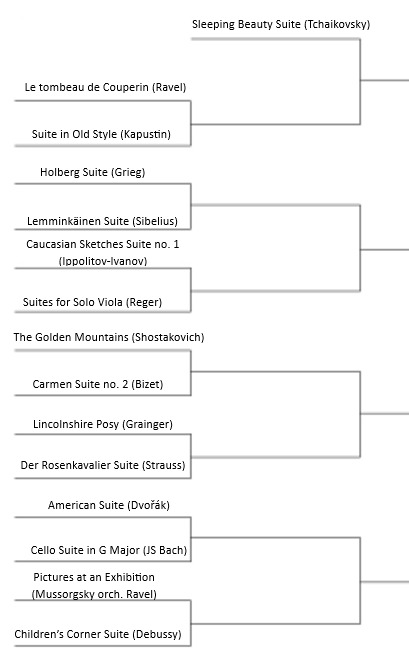
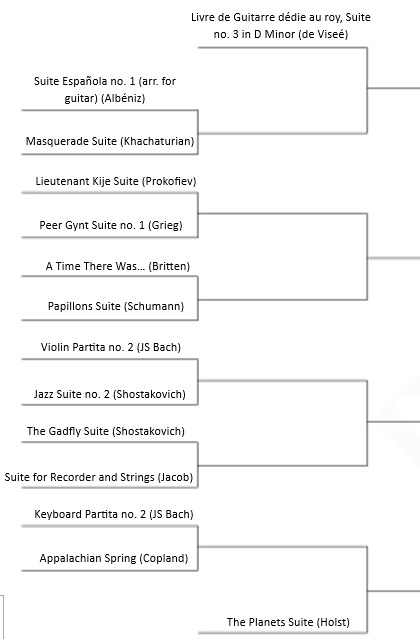

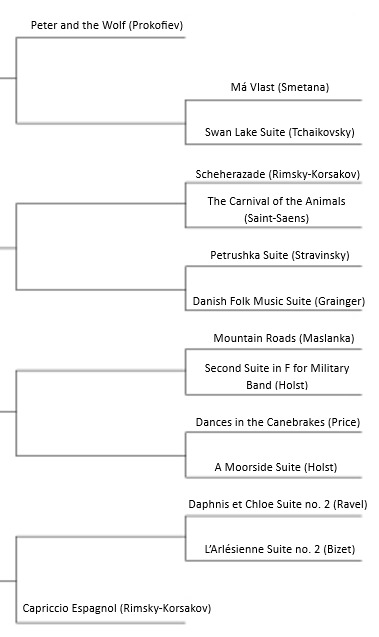
The top left:
Sleeping Beauty Suite vs Bye
Le tombeau de Couperin vs Suite in Old Style
Holberg Suite vs Lemminkäinen Suite
Caucasian Sketches Suite no. 1 vs Suite for Solo Viola
The Golden Mountains vs Carmen Suite no. 2
Lincolnshire Posy vs Der Rosenkavalier Suite
American Suite vs Cello Suite in G Major
Pictures at an Exhibition vs Children's Corner Suite
The bottom left:
Livre de Guitarre dédie au roy, Suite no. 3 in D Minor vs Bye
Suite Española no. 1 vs Masquerade Suite
Lieutenant Kije Suite vs Peer Gynt Suite no. 1
A Time There Was vs Papillons Suite
Violin Partita no. 2 vs Jazz Suite no. 2
The Gadfly Suite vs Suite for Recorder and Strings
Keyboard Partita no. 2 vs Appalachian Spring
The Planets Suite vs Bye
The top right:
Suite from Hamlet vs Bye
English Folk Song Suite vs Mother Goose Suite
Orchestral Suite no. 3 in D vs St Paul's Suite
The Firebird Suite vs Symphonic Dances
Romeo and Juliet Suite No. 2 vs Dance Suite
Giselle Ballet Suite vs Keyboard Partita no. 6
First Suite in E-flat for Military Band vs Magnificant in Bb Major
The Nutcracker Suite vs Violin Partita no. 3
The bottom right:
Peter and the Wolf vs Bye
Má Vlast vs Swan Lake Suite
Scheherazade vs The Carnival of the Animals
Petrushka Suite vs Danish Folk Music Suite
Mountain Roads vs Second Suite in F for Military Band
Dances in the Canebrakes vs A Moorside Suite
Daphnis et Chloe Suite no. 2 vs L’Arlésienne Suite no. 2
Capriccio Espagnol vs Bye
Please note all of these matches (including byes) were randomly allocated using a random number generator and I will not be making any changes. I will post 1 poll per day starting from 12:00 am GMT time on the 1st of December (in 24 hours time at time of posting), with each poll lasting for a week to give everyone time to listen to each submission.
34 notes
·
View notes
Text

Tuesday, 11-19-24, 7pm Pacific
'Evenin' all, Mr. Baggins here with a set of music to soothe your achin' nerves and help ease us all into a good night. I thought we'd begin a survey of the complete recordings Marriner and The Academy made of Schubert's Symphonies. Let's hear them play Schubert's Symphony No. 1, in D major, D82.
youtube
Next we hear the legendary Chilean-American pianist Claudio Arrau play the music of Claude Debussy, his "Suite Bergamasque", from his classic Philips recordings of Debussy's complete piano works.
youtube
Next we hear a group of Debussy's songs, his "Proses Lyrique", sung by the marvelous Elly Ameling, with her accompanist Dalton Baldwin, recorded in the '70s, when she was at her peak. Lovely pieces sung by one of the loveliest voices ever to grace the planet, I do hope you enjoy!
youtube
Now let's turn the clock back to Vivaldi. I've played you the "Fall" movement from my absolute favorite recording of The Four Seasons. I thought tonight we might hear the entire suite. Once again, here is violinist Susanne Lautenbacher and the Wurttemberg Chamber Orchestra, with Vivaldi's "The Four Seasons".
youtube
Let's move now to music of Ravel; this is his ballet "Daphnis et Chloe", the complete piece, played by Charles Munch and The Boston Symphony Orchestra in another classic RCA Living Stereo recording, from 1955.
youtube
Let's check back in with Neville and The Academy for a little Vaughan Williams, three pieces to round out our evening. First let's hear his "Fantasia On Greensleeves".
youtube
Next up, his gorgeous "Fantasia on a Theme By Thomas Tallis".
youtube
And let's end the evening on a truly transcendant note: here is "The Lark Ascending", their classic 1972 recording.
youtube
That's all the space we have for this evening, I do hope you've enjoyed. This is Mr. Baggins, wishing you a peaceful and restful good night. I'll return at 8am with your Morning Coffee Music.
Until then, dream sweet dreams, babies, dream sweet dreams.
Baggins out.
youtube

6 notes
·
View notes
Text
Daphnis et Chloe suite the most obvious source of western classical inspiration for Joe hisaishi's music i've yet come across, wow
3 notes
·
View notes
Note
What's your opinion on the funny Bolero man?
okay, I have a LOT of opinions on Ravel, and I’ve actually done quite a bit of research on him. He’s one of my favourite composers, and his life story just… god.
So the first thing I want to say about Ravel is that his music tends to be very easily misunderstood, and this is according to Ravel himself. Ravel is a toymaker, a tinker. He called himself “artificial by nature,” and that’s the key thing to understand. Ravel is artificial, but that’s not necessarily a bad thing; in fact, that’s part of his appeal and what makes his music unique. Much of the time, he’s not directly seeking to express an emotion, but rather a depiction, an imitation of one. It’s like he’s creating clockwork automatons of living things that are not meant to be lifelike, but to be clockwork. He imitates other composers in “A la Maniere de Borodin/Chabrier,” objects and animals in “L’enfant et les Sortileges,” and the styles of other cultures around the world across his body of work. On the subject of the last one, Ravel does often have a tendency towards Orientalism, which can be sometimes cringey in today’s social environment (“Chinoiserie” and a general fascination with the East was very much in fashion in his day), but I think Ravel’s impressions of Asian, Middle Eastern, and even European music (including Spain; Ravel was part Basque and was very proud of that) can be best understood when compared to Disney’s “Small World” ride. You’re not getting an authentic picture of the world; you’re getting a mechanical fantasy based on it.
I bring up machines a lot when I talk about Ravel, not just in reference to his music, but also to his life. Stravinsky referred to him as the “most perfect of Swiss watchmakers,” his father was in inventor (who was also responsible for creating a machine that resulted in a fatal mishap, aptly called the “Whirlwind of Death;” look it up), and he had a lifelong fascination with toys and mechanical objects. We see them prominently featured in his opera “L’Heure Espagnole,” the vocal piece “Noel des Jouets” (a little-known piece about the Nativity, except make it steampunk!), and of course, Bolero, which is perhaps one of the most misinterpreted Ravel works.
The thing about Bolero is it’s not supposed to be sexy. And many Ravel pieces are- Nahandove from “Chansons Madacasses” (a cycle which, I should add, also includes a striking rebuke of French colonialism in “Aoua”), Daphnis et Chloe’s Bacchanale, maybe even La Valse. However, Ravel stated that “Bolero should be played at a constant speed from beginning to end, in the plaintive, monotonous style of Arabo-Spanish melodies.” He considered it his only masterpiece, not because of its beauty or virtuosity, but because it achieved what he set out to write- a piece with “no form properly speaking, no development, no modulation, or hardly any.”
I think this is where misinterpretations of Ravel most commonly arise, when his artificiality is mistaken for genuine passion. Famously, with his “Pavane for a Dead Princess,” Ravel disliked interpretations that were too slow, remarking that “it’s a Pavane for a dead princess, not a dead Pavane for a princess.” While slow interpretations may intend to be elegiac, a steady tempo brings another meaning to the title- not that this Pavane would be heard at a princess’ funeral, but rather something that a princess from a past time would have danced while alive. And we can also connect this to the view of death Ravel takes in “Le Tombeau de Couperin,” a work with each movement dedicated to a friend who died in WWI (Ravel served as a nurse and supply truck driver). Despite being a memorial piece, “Le Tombeau” is largely joyful; the “Minuet” displays some sentimentality, but this work is largely dedicated to celebrating life, rather than mourning death.
Another thing to consider about Ravel was that he made his aesthetic his entire personality. And I’m dead serious about that. Ravel adopted the fashion style and philosophy of Dandyism, in which one was to make themselves stylish and presentable, while appearing detached and aloof from the rest of the world, keeping inner feelings private. Ravel was very particular about his personal appearance (he was once late to a funeral because he couldn’t decide which suit to wear!) and hardly divulged deeply personal information in his private correspondence- for instance, while it’s likely he may have been aromantic, as far as we know, we don’t have any evidence of Ravel having any committed romantic or sexual partners (although we do have a few accounts from other people claiming he sometimes saw prostitutes). He kept his passions and fears largely secret, and this is further reflected in his works; while he often dedicated them to friends and patrons, I can’t say I know of anything by Ravel that’s explicitly or otherwise proven to be biographical. As a composer, he takes a “Dandyistic” approach as well, giving us beautiful works while hardly allowing us a window into his mind.
One thing in particular about Ravel has haunted me, and that’s how he died. While he’d been showing signs of mental deterioration in years prior, in 1932, he got into a taxi accident, which likely accelerated what would be diagnosed as aphasia, although we still don’t know what exactly he had. For the next five years, Ravel would gradually become unable to read, write (both words and music), and play the piano, and sometimes had difficulty controlling his movements and recognizing people. Even prominent biographers like Roger Nichols express how devastating this period of Ravel’s life was, as his friends tried to make it, in Nichols’ words, “even remotely tolerable.” During this time, Ravel could compose in his head, but not write anything down, and was even planning at least two major works- an opera called “Jeanne d’Arc,” and a ballet called “Morgiane.” His friends took him on a trip to Morocco and he immensely enjoyed it, appearing to temporarily improve, but afterwards, his mental health continued to decline. Looking at Ravel’s correspondence from this time is devastating, as we see his handwriting get messier and messier, then only typewritten letters, and then nothing at all. At a performance of his ballet, “Daphnis et Chloe,” Ravel reportedly began to cry, remarking, “and yet, there is still so much music inside my head!”
Sources vary on whether or not Ravel was aware of the fact, but his brother Edouard arranged for him to have an operation with the famous brain surgeon Clovis Vincent. Afterwards, Ravel woke up from the surgery, asked to see his brother, but fell comatose, dying in his sleep on December 28th, 1937. Dr. Vincent reportedly did not find ant tumours.
… anyway, this ended up way longer than I expected it to be. but I really like ravel
#maurice ravel#ravel#classical music#music history#composers#composer#classical music history#french music history
42 notes
·
View notes
Text








Shin Jia (KOR): Daphnis et Chloe | 2024 JGP Ljubljana Cup, FS
#figure skating#shin jia#jia shin#jgp 2024#fskateedit#jgp ljubljana 2024#my gifs#i felt she was rushing the program because of nerves#but i know she has it in her to improve on this#probably wont make it to the jgpf :(#hwaiting jia hope knats will be amazing for you
47 notes
·
View notes
Text
Photos from my Opera Garnier Trip 2 of 3
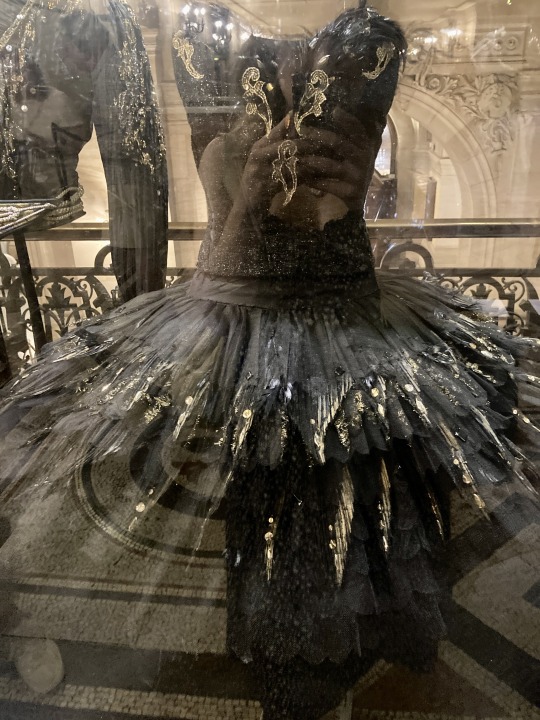
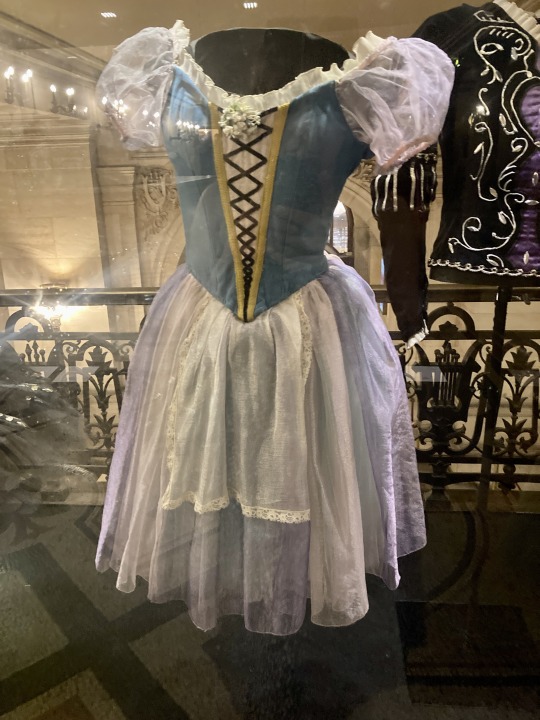

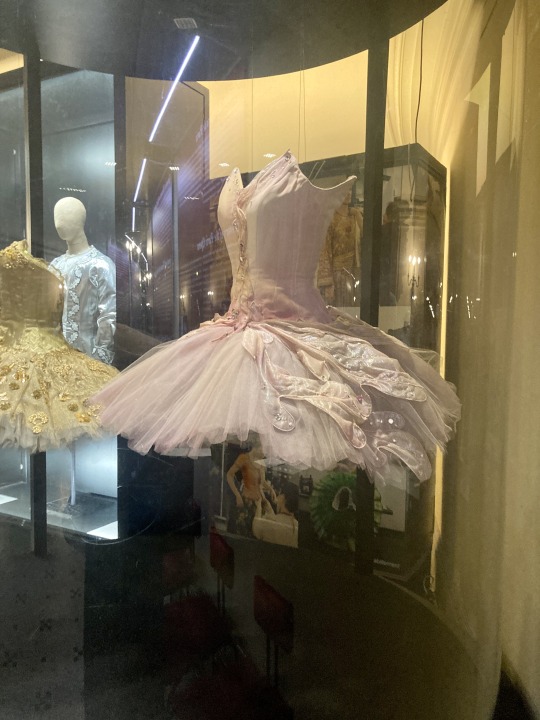
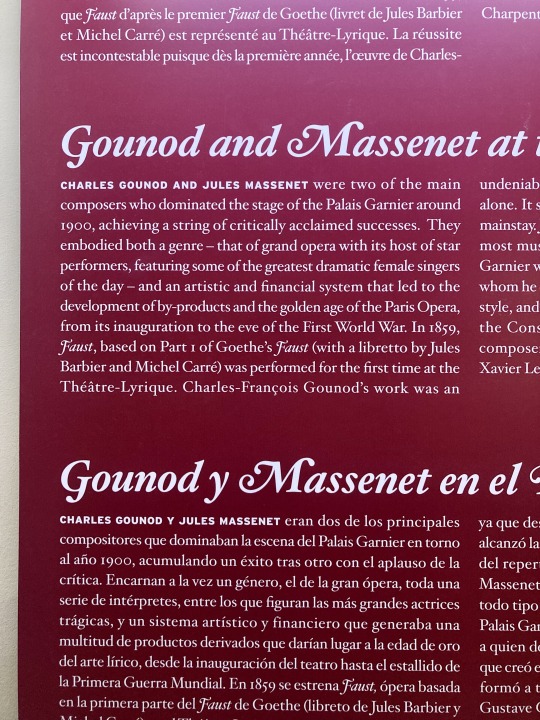
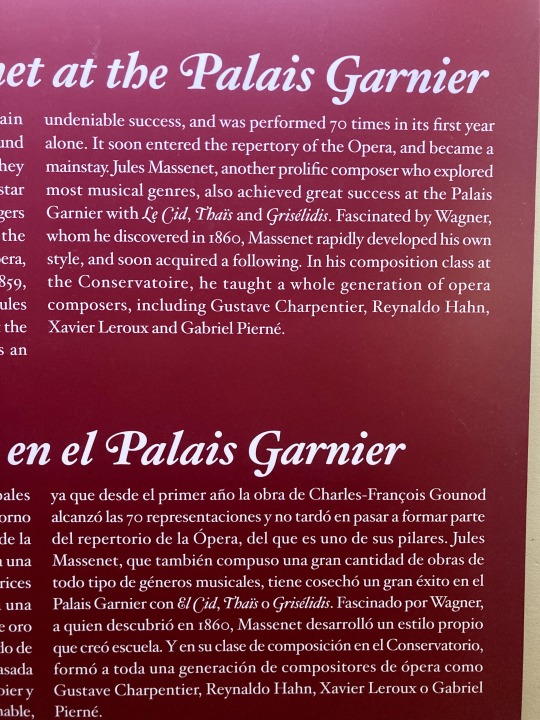
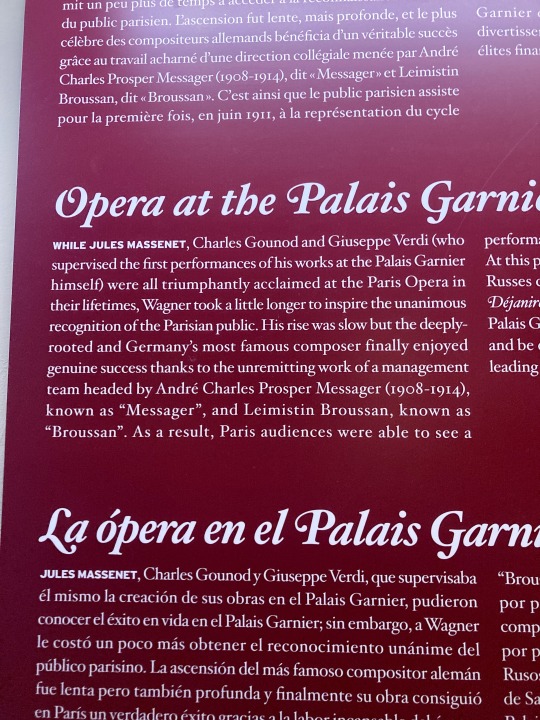

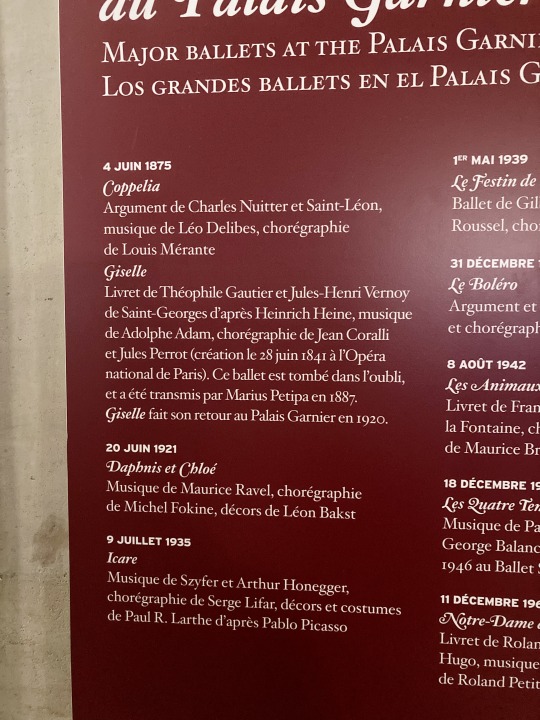

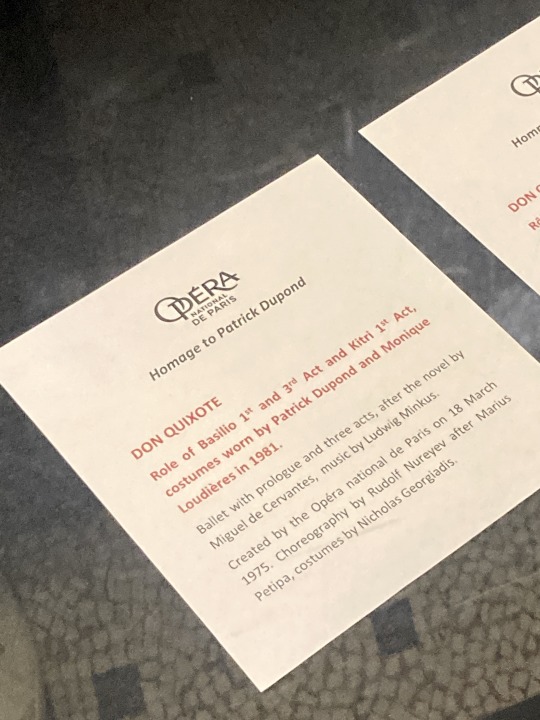
Took some photos of the exhibit up at the Opera Garnier for my own (cough cough) research purposes and thought it might be helpful for others! Thought the Don Quixote dress looked awfully familiar!
Transcript of the information under the cut:
Gounod and Massenet at the Palais Garnier
Charles Gounod and Jules Massenet were two of the main composers who dominated the stage of the Palais Garnier around 1900, achieving a string of critically acclaimed successes. They embodied both a genre - that of grand opera with its hoses of star performers, featuring some of the greatest dramatic female singers of the day - and an artistic and financial system that led to the development of by-products and the golden age of the Paris Opera from its inauguration to the eve of the First World War. In 1859, Faust, based on Part 1 of Goethe's Faust (with a libretto by Jules Barbier and Michel Carre) was performed for the first time at the Theater-Lyrique. Charles-Francois Gounod's work was an undeniable success and was performed 70 times in its first year alone. It soon entered the repertory of the Opera and became a mainstay. Jules Massenet, another prolific composer who explored most musical genres, also achieved great success at the Palais Garnier with Le Cid, Thais, and Griselidis. Fascinated by Wagner, whom he discovered in 1860, Massenet rapidly developed his own style, and soon acquired a following. In his composition class at the Conservatoire, he taught a whole generation of opera composers, including Gustave Charpentier, Reynaldo Hahn, Xavier Leroux, and Gabriel Pierne.
Opera at the Palais Garnier around 1900
While Jules Massenet, Charles Gounod, and Giuseppe Verdi (who supervised the first performances of his words at the Palais Garnier himself) were all triumphantly acclaimed at the Paris Opera in their lifetimes, Wagner took a little longer to inspire the unanimous recognition of the Parisian public. His rise was slow but the deeply-rooted and Germany's most famous composer finally enjoyed genuine success thanks to the unremitting work of a management team headed by Andre Charles Prosper Messager (1908-1914) known as "Messager", and Leimistin Broussan, known as "Broussan". As a result, Paris audiences were able to see a performance of the entire Ring cycle for the first time in June 1911. At this period, the Palais Garnier hosted Serge Diaghilev's Ballet Russes company, and Richard Strauss' Salome and Saint-Saens Dejanire both entered the repertory. During the Belle Epoque, the Palais Garnier was one of the chief places for Paris society to meet and be entertained, with an audience of subscribers made up of leading financiers, industrialists, and politicians.
Major Ballets at the Palais Garnier
4 June 1875
Coppelia - Argument de Charles Nuitter et Saint-Leon, Musique de Leo Delibes, choregraphie de Louis Merante
Giselle - Livret de Theophile Gautier et Jules-Henry Vernoy de Saint-Georges d'apres Heinrich Heine, musique de Adolphe Adam, choregraphie de Jean Coralli et Jules Perrot (creation le 28 Juin 1841 a l'opera national de Paris). Ce ballet est tombe dans l'oubli, et a ete transmis par Marius Petipa en 1887. Giselle fait son retour au Palais Garnier en 1920
20 Juin 1921
Daphnis et Chloe
musique de Maurice Ravel, choregraphie de Michel Fokine, decors de Leon Bakst
9 Jullet 1935
Icare
Musique de Szyfer et Arthur Honegger, choregraphie de Serge Lifar, decors et costumes de Paul R Larthe d'apres Pablo Picasso
19 notes
·
View notes
Text
June 3, 1809
Couche at 12. Rose at 7. Tro. bu. Pas bien.¹ Sor. before breakfast to U. Fredrick; 1 rix dollar. Tro. usé.² Breakfast at 9. Read a romance, “Les Amour de Daphnis et Cloe,³” traduit du Grec de Longus par Arryot.⁴ This romance is supposed to have been written after that of Heliodorus (“Theagenes and Chariclea”). Dined on sugar, water, and bread. A promenade seul to Kongl. Djur Garden,⁵ about two miles. Returned sans aventure.⁶ Tea at 9.
1 Had drunk too much and did not feel well. 2 Too much used up. 3 So in the MS. 4 “The Amours of Daphnis and Chloe,” translated from the Greek of Longus by Arryot. 5 For Sw. Konigliga Djurgård. 6 Without adventure.
14 notes
·
View notes
Note
so i listened to la mer because i love basically anything abt the sea AND I LOVE THE SIRENS ONE !!
yes!!! i thought you would!!! you are my water elemental friend and debussy is very… watery . you should try ravel’s daphnis et chloe suite no.2…. it’s so magical
3 notes
·
View notes